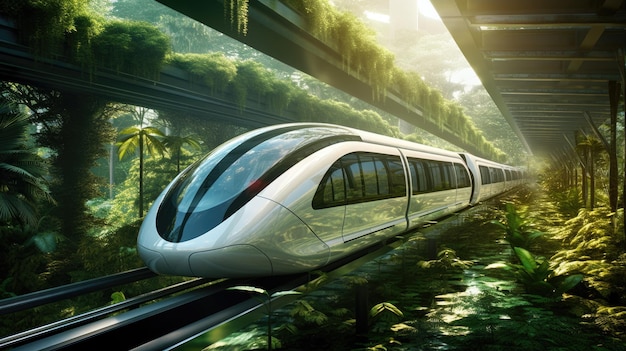Cutting Emissions: How Wind-Powered Trains Can Revolutionize Railways

Table of Contents
The Environmental Impact of Current Railway Systems
Traditional railway systems, while often touted as more environmentally friendly than road transport, still carry a substantial carbon footprint. This stems from the energy sources used to power them.
Greenhouse Gas Emissions from Diesel and Electric Trains
Diesel trains directly emit greenhouse gases (GHGs) through the combustion of fossil fuels. Electric trains, while seemingly cleaner, often rely on electricity generated from coal, natural gas, or nuclear power plants, contributing indirectly to GHG emissions.
- Diesel trains: Studies show that diesel trains can emit upwards of 100 grams of CO2 per passenger kilometer, significantly higher for freight trains. This doesn't account for particulate matter and other pollutants harmful to public health.
- Electric trains: While emitting less CO2 directly, their carbon footprint depends heavily on the electricity source. Grid electricity often relies on fossil fuels, leading to significant indirect emissions, varying by region and energy mix.
- Limitations of Current Electrification: The extensive infrastructure required for widespread electrification is expensive and time-consuming, making it impractical in many areas.
How Wind-Powered Trains Work
Wind-powered trains harness the kinetic energy of wind to generate electricity for traction, offering a sustainable alternative to fossil fuels and grid dependence.
Harnessing Wind Energy for Traction
Several technological approaches are being explored:
- Alongside-Track Wind Turbines: Large wind turbines positioned alongside railway lines generate electricity that feeds into the railway network, powering passing trains.
- Onboard Wind Turbines: Smaller, lighter wind turbines mounted on the trains themselves generate supplemental power. This approach requires advanced energy storage solutions.
- Hybrid Systems: Combining onboard wind turbines with battery storage and potentially solar panels allows for a more reliable and efficient energy supply, even in low-wind conditions.
The mechanics involve converting wind energy into mechanical energy via the turbine blades, then converting this into electricity through a generator. This electricity then powers the train's motors, or charges batteries for later use. However, challenges remain, such as fluctuating wind speeds and the need for effective energy storage.
Economic Advantages of Wind-Powered Trains
Beyond environmental benefits, wind-powered trains offer significant economic advantages.
Reduced Operational Costs
The reliance on a freely available resource like wind dramatically reduces fuel costs compared to diesel or grid-dependent electric trains.
- Lower Running Costs: A substantial reduction in fuel expenditure translates into significant long-term cost savings for railway operators.
- Reduced Maintenance: Wind turbines, while requiring maintenance, generally have lower maintenance costs than internal combustion engines.
- Government Incentives: Many governments are implementing incentives and subsidies to promote the adoption of green technologies, potentially reducing the initial investment costs.
- Revenue Generation: Excess energy generated by the wind turbines can potentially be fed back into the grid, creating an additional revenue stream.
Technological Advancements and Future Prospects
Significant progress is being made in wind-powered train technology.
Current Research and Development
Research institutions and companies worldwide are actively involved in developing more efficient wind turbines, advanced battery technologies, and sophisticated energy management systems.
- Key Players: Several universities and private companies are at the forefront of research and development, constantly pushing the boundaries of wind-powered train technology.
- Future Applications: Further advancements could lead to the development of fully autonomous wind-powered trains, integrating smart grids, and incorporating other renewable energy sources.
- Pilot Projects: While still in its early stages, several pilot projects are demonstrating the feasibility and potential of wind-powered train systems.
Addressing Challenges and Concerns
Despite the numerous advantages, challenges remain in the implementation of wind-powered trains.
Infrastructure Requirements and Costs
The initial investment required for adapting existing infrastructure or building new wind-powered railway lines is substantial.
- Infrastructure Integration: Integrating wind power into existing railway infrastructure presents considerable logistical challenges.
- Economic Feasibility: A thorough cost-benefit analysis is necessary to evaluate the economic viability of large-scale implementation.
- Visual Impact: The visual impact of wind turbines along railway lines needs careful consideration, requiring aesthetically pleasing design and placement.
Conclusion
Wind-powered trains offer a compelling solution to reduce railway emissions, cut operational costs, and create a more sustainable transportation future. By harnessing the power of wind, we can significantly lessen our reliance on fossil fuels and create a greener railway network. The key benefits—reduced emissions, economic advantages, and technological advancements—make a strong case for investing in wind-powered trains. This technology represents a significant leap towards a cleaner, more sustainable future for railways. We encourage you to learn more about wind-powered train technology and support initiatives promoting the adoption of wind-powered train technology and the future of wind-powered railways. Let's work together to build a more sustainable and efficient transportation system by embracing innovative solutions like investing in wind-powered trains.

Featured Posts
-
 The Edwards Berlanga Fight Star Status A Side Negotiations And Benavidezs Absence
May 04, 2025
The Edwards Berlanga Fight Star Status A Side Negotiations And Benavidezs Absence
May 04, 2025 -
 Watch The Cubs Vs Dodgers Mlb Tokyo Series Online A Streaming Guide
May 04, 2025
Watch The Cubs Vs Dodgers Mlb Tokyo Series Online A Streaming Guide
May 04, 2025 -
 Le Elezioni Francesi E L Avanzata Dell Estrema Destra Il Ruolo Di Bayrou
May 04, 2025
Le Elezioni Francesi E L Avanzata Dell Estrema Destra Il Ruolo Di Bayrou
May 04, 2025 -
 Government Intervention And Airline Relief Packages During Oil Crises
May 04, 2025
Government Intervention And Airline Relief Packages During Oil Crises
May 04, 2025 -
 Bgt Fans Outraged Over Semi Final Winner
May 04, 2025
Bgt Fans Outraged Over Semi Final Winner
May 04, 2025
